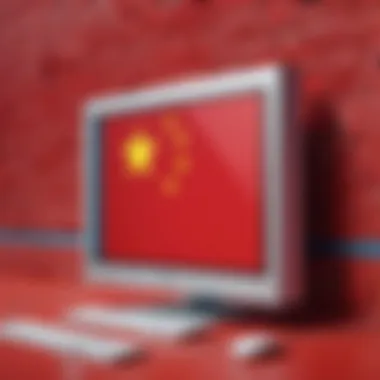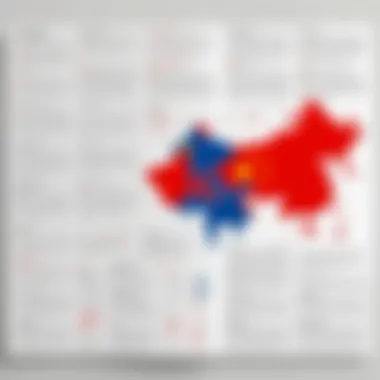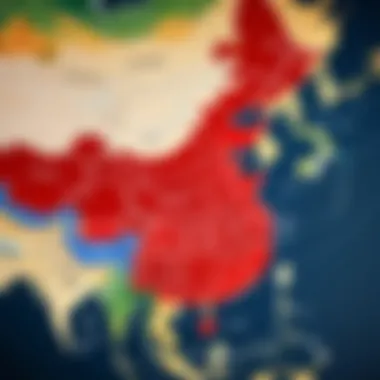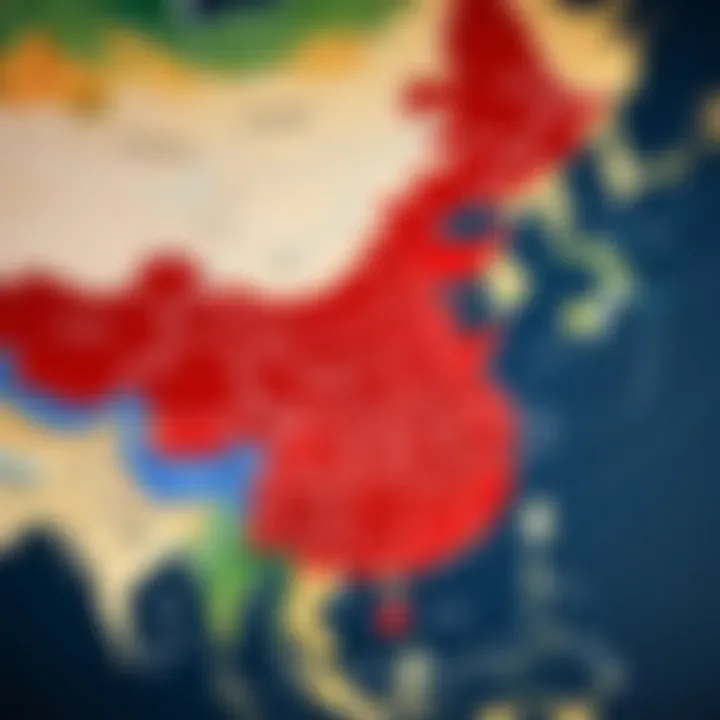Understanding the Complexities of China's Great Firewall


Intro
The phenomenon of digital censorship is not just a matter of policy, but rather a tapestry woven with threads of culture, history, and technology. When discussing China's approach to internet regulation, few elements are as pivotal as the Great Firewall. It stands as a symbol of state control over the digital realm, shaping how millions of users interact with information.
This intricate censorship architecture serves multiple purposes: safeguarding national security, maintaining social harmony, and controlling dissent. But the implications stretch far beyond the realm of simple content blocking, inviting a myriad of questions about freedom, privacy, and access to information.
In this exploration, we will delve into the technical workings, historical backdrops, and the socio-political landscape that nourishes this digital fortress. Additionally, we will consider the voices of users—both those within China and those that look in from the outside. As we unpack these layers, it becomes clear that understanding the firewall is essential, not just for tech aficionados, but for anyone interested in the broader discussion on digital rights and freedoms.
Let’s embark on this journey, which promises to be as enlightening as it is essential.
Technology Insights
In the sphere of digital regulation, technical complexity plays a pivotal role. The Great Firewall isn't simply a monolithic structure; it's a sophisticated blend of strategies and technologies designed to control the flow of information. Among these, IP blocking, DNS tampering, and deep packet inspection stand out as critical mechanisms.
Latest Tech Trends
The technological landscape is constantly changing, yet the underlying principles driving censorship remain largely unchanged. Increasingly, AI and machine learning are becoming instrumental in optimizing these censorship techniques. Algorithms can predict which sites may have the potential to spark public unrest or reveal sensitive information, allowing for preemptive blocking.
It’s also worth mentioning that tools like VPNs and proxies are frequently employed by users aiming to circumvent these restrictions. However, the authorities are keenly aware of these technologies. They continually adapt their strategies to mitigate these workarounds, creating a cat-and-mouse dynamic that highlights the evolution of digital censorship technology.
Innovation in Tech
While the Great Firewall itself can be viewed as a lead weight on internet freedom, it paradoxically spurs innovation among tech-savvy individuals. Startups aiming to provide enhanced security and privacy measures have emerged, working to keep information flowing. Technologies like mesh networks are gaining traction as alternatives to prescribed internet access, showcasing human resilience in the face of stringent controls.
Product Reviews
Products such as NordVPN and ExpressVPN have gained popularity. These VPNs claim to enable users to access blocked content while ensuring their privacy. They raise a critical question: how effective are these tools in a landscape where authorities are constantly evolving their surveillance techniques? User experiences vary; some find success in bypassing restrictions while others remain stymied. Understanding these tools and their limitations can clarify how users can navigate this complex digital landscape.
"In a world where the flow of information is controlled, resilience in technology becomes a means of liberation."
Ending
This overview shines a light on the inherent tension between control and freedom in the domain of digital communication. While the Great Firewall serves as an imposing barrier, its presence also inspires a quest for information and innovation that cannot be easily suppressed. As we continue our exploration, we will delve into historical context and socio-political impacts, enriching our understanding of this intricate web of regulations and their consequences.
Historical Context of Censorship
Understanding the historical context of censorship in China is pivotal to comprehending the development of the Great Firewall. The history of censorship here is not new; it stretches back centuries, with state control over information seen as a method of maintaining order and political power. In today's digital age, this ancient practice has evolved into a highly technical and comprehensive system of internet controls.
The Evolution of Internet Control
The evolution of internet control in China can be traced back to the introduction of the internet into the country in the early 1990s. At the time, the government viewed the internet as a double-edged sword. On one hand, it was a tool for economic advancement and modernization. On the other, it presented risks of uncontrolled access to information that could undermine state authority.
As the internet grew in popularity, so did the government’s efforts to regulate it. Initial attempts at controlling internet access were mostly reactive. Cyber cafes sprang up rapidly, and local governments scrambled to impose restrictions, often creating confusion. By the late '90s, Beijing recognized that a more structured approach was needed, leading to the establishment of the Golden Shield Project in 1998, which laid the groundwork for what we now know as the Great Firewall.
This project served as a watershed moment in internet governance. The strategy shifted from an initial laissez-faire attitude to aggressive monitoring and filtering of content. By the early 2000s, controlled access became more systematic, incorporating tools for monitoring user behavior and blocking specific sites. Hence, internet control transformed from a chaotic patchwork into a state-sanctioned regime that influences every aspect of online life.
Significant Legislative Milestones
Several legislative and regulatory milestones punctuate the history of internet censorship in China, each reinforcing the government's firm grip on information dissemination.
- Regulations on Internet Content Management (2000): This early regulation required websites to register with the government and prohibited any dissemination of information that undermined state authority or social stability.
- The Anti-Secession Law (2005): Aimed at Taiwan, this law further emphasized the government’s stance on territorial integrity and reflected a broader intent to suppress dissenting narratives.
- The Cybersecurity Law (2017): Perhaps one of the most comprehensive laws to date, it mandated that companies in China store user data locally and granted authorities sweeping powers to access that information under the guise of protecting national security.
Each of these milestones contributes a brick to the edifice of the Great Firewall, reinforcing the central narrative: control over the internet is essential for maintaining state power in China. Given the vast implications for freedom of expression and the dissemination of information, the historical context becomes not just a backdrop but a crucial element in understanding the intentions and mechanisms of the Great Firewall.
"Censorship can be understood as more than an impediment to expression; it is a systematic approach to shaping reality, which becomes vital in a society where media narratives are dominated by state interests."
In the digital era, where headlines and biases can spread as fast as light, pinpointing the historical context of censorship allows us to grapple with its long-term impact. Reflecting upon this landscape not only adds depth to our understanding of the Great Firewall itself but also places us one step closer to navigating the often-treacherous waters of information in an age where data is increasingly weaponized.
Technical Architecture
The architecture behind the Great Firewall is a marvel of modern technology intertwined with political ideology. It not only serves as a critical line of defense for the Chinese government against unwanted foreign influence but also reflects the complexity of digital censorship. By understanding the technical underpinnings, one can appreciate its multifaceted role in shaping online discourse in China.


Key Components of the Great Firewall
At the heart of the Great Firewall are several key components that work in unison to manage internet traffic. These elements include:
- Packet Interception: This process involves monitoring and capturing packets traveling through the network. Helpful for filtering out specific content based on keywords or source.
- Filtering and Blocking: The most prominent feature; websites that fit certain criteria are identified and effectively rendered inaccessible. This can include anything from well-known social media platforms to international news outlets.
- Traffic Redirection: Manipulating users’ attempts to visit restricted sites by redirecting them to government-approved alternatives. This approach creates an illusion of accessibility while controlling the narrative.
- Surveillance Systems: Integrated tools that monitor users' online activities, which are extensive and scrutinize everything from social media posts to online searches.
Each of these components plays a pivotal role in maintaining the integrity of the government’s digital narrative.
Methods of Content Filtering
The methods employed to filter content are as varied as they are effective. The most common techniques include:
- Keyword Blocking: This involves scanning for specific words or phrases that could expose sensitive information or dissenting views. It’s a straightforward yet blunt instrument, often leading to significant collateral damage in communications.
- URL Blacklisting: URLs identified as politically sensitive are systematically blocked. The process can be instantaneous, and users often remain unaware of what they can’t access until they try visiting such sites.
- Deep Packet Inspection (DPI): A sophisticated variant that goes beyond basic filtering. DPI analyzes the content of packets, allowing authorities to detect and censor a wider array of information based on context, rather than just predefined words.
Each method has its own caveats and effectiveness, shaping the experience of internet users in ways many outside of China may not fully grasp.
The Role of DNS Poisoning
DNS poisoning is an underhanded tactic that plays a crucial role in the Great Firewall’s operation. At its core, it involves altering the responses of DNS queries to mislead users attempting to access blocked sites. Here’s how it works:
- User Attempts to Access a Blocked Site: A user types in the URL of a news outlet prohibited by the government.
- DNS Query Interception: The request goes through a DNS server that the government controls, instead of the legitimate site.
- Altered Response: Instead of the correct IP address for the blocked site, the user receives a false IP address, often leading to a government-controlled page. This page may contain misinformation or simply state that the site is unavailable.
“By manipulating DNS responses, the firewall creates an additional layer of control, shrouding the censorship process from plain sight. Users often think they have hit an error, rather than realizing they’ve been led astray.”
- Impacts on User Awareness: This subtlety can lead to ignorance about broader censorship, making it difficult for citizens to gauge the extent of their limited access.
Therefore, DNS poisoning serves not only as a method of restricting information but also as a means of shaping perceptions and reactions to that restriction.
Socio-Political Implications
The socio-political implications of the Great Firewall of China are profound and multifaceted. The firewall serves as both a tool for control and a shield for the government, encapsulating its approach to managing information and dissent. It's not just about limiting access to certain websites; it influences how citizens perceive their freedom, how ideas circulate, and, by extension, how power is contested in society. Understanding these implications gives invaluable insight into the mechanics behind not only Chinese governance but also modern governance in an increasingly digital world.
Impact on Freedom of Expression
In many respects, the Great Firewall embodies the struggle between state authority and individual liberties. Freedom of expression, a cornerstone of democratic societies, is significantly stifled under this regime. Citizens find themselves navigating a labyrinthine system that actively restricts their voices and choices.
When individuals attempt to voice dissent or engage in open dialogue, they encounter multiple barriers. These barriers go beyond simple censorship; they forge a culture of self-censorship among citizens, as fear of retribution looms large. Many people may hesitate to discuss sensitive topics, fearing that their communications could be monitored or lead to repercussions from the state.
"The firewall does not just filter content; it filters thoughts."
It’s a classic case of fishing in murky waters—the lack of transparency makes users wary, and fear breeds silence. Activists and journalists are among those who face heightened scrutiny, further complicating their roles as disseminators of information. By curtailing the freedom of expression, the state is working to shape public discourse, effectively rewriting the rules of engagement for digital participation.
Effects on Academic Research
The landscape of academic research in China is likewise impacted by the Great Firewall. Scholars and researchers who wish to access global databases, journals, or even seek collaborations with international institutions face significant hurdles. The restrictions enforce a form of intellectual isolation, where knowledge is not just curated but also confined within state-approved narratives.
For instance, academics often resort to workarounds like VPNs, but these tools themselves risk repercussions, raising the stakes for those willing to venture outside the accepted norms. Important discussions on pressing global issues take place behind a curtain, as the firewall effectively narrows the flow of information that could foster innovation or critical inquiry.
Furthermore, research that contradicts official viewpoints or finds itself in politically sensitive areas may find publication in local journals fraught with complications. The potential for censorship leads to self-regulation among researchers, inhibiting bold inquiries and fostering an environment where conformity trumps originality.
Influence on International Relations
When it comes to international relations, the Great Firewall's influence extends far beyond national boundaries. The firewall represents China's broader efforts to control its narrative on the global stage, particularly as it relates to issues like human rights, trade, and governance.
Countries dealing with China must navigate these dynamics carefully. On one hand, the firewall indicates a level of control that may deter foreign investment or collaboration in technology; on the other hand, it signals China's intent to safeguard its sovereignty against what it perceives as external threats. The complexities grow as foreign entities try to engage with Chinese citizens while remaining respectful of local laws.
Moreover, the firewall complicates China's participation in global dialogues, as issues of internet freedom and cybersecurity often become sticking points in negotiations. Countries that prioritize open internet access often clash with China's model, leading to tensions that ripple through diplomatic channels. It shapes alliances, conflicts, and trade relations, with implications that extend beyond the digital realm.
In summary, the socio-political implications of the Great Firewall of China transcend mere digital censorship. They affect individual freedoms, the integrity of academic research, and the nature of international relations, creating a complex tapestry of governance and control that advocates for open dialogue must grapple with.
User Experiences and Adaptation


In the realm of internet censorship, understanding how individuals cope with and navigate restrictive measures is vital. The User Experiences and Adaptation section emphasizes how citizens adapt to the Great Firewall of China, blending creativity and technological savvy in their attempts to access the unfiltered internet. The dynamic between the state’s control and personal resistance paints a vivid picture of the ongoing struggle for digital freedom.
Navigating the Firewalls as a Citizen
For many Chinese citizens, dealing with the intricacies of the Great Firewall has become a part of daily life. Each day, they weigh their access to online information against the potential risks.
Most users are not completely unaware of the censorship; rather, they live with its limitations while seeking pathways around it. Many rely on popular chat applications, like WeChat, that have built-in features to communicate securely. Individuals may share tips and tricks about lesser-known platforms that offer less resistant connectivity.
Moreover, the impact of regional differences can’t be ignored. Urban centers such as Beijing and Shanghai may afford citizens slightly more leeway due to their exposure to global trends, while those in rural areas often have to make do with whatever is accessible within the confines of the firewall.
“The digital landscape isn’t uniformly grey; some areas radiate shades of resilience,” said one activist who prefers to remain anonymous.
Use of VPNs and Proxies
The use of VPNs (Virtual Private Networks) has surged among Chinese internet users trying to bypass censorship blocks. These tools create encrypted tunnels through which data travels, theoretically shielding users’ online activities from prying eyes. However, the state has recognized this trend and continually works to throttle access to reputable VPNs.
Many people opt for lesser-known VPN services or employ proxies that offer a fleeting glimpse of a freer internet. This cat-and-mouse game involves constant adjustments as users find themselves needing to switch providers often. When a VPN gets blocked, it can feel like a digital game of whack-a-mole, leading to frustration, yet the persistent search for new methods continues.
Some individuals prepare for this by compiling lists of available proxies or frequenting forums on websites like Reddit to find recommendations.
- Advantages of VPNs:
- Challenges:
- Encrypted connection that hides online activity
- Bypasses geographic restrictions
- Access to global content
- Expensive subscription fees
- Possible government crackdowns on certain services
- Inconsistent performance
The Role of Social Media in Censorship Evasion
Social media has become a double-edged sword in the battle against censorship. While platforms like Weibo and WeChat circulate government-approved narratives, they also serve as vital venues for discussion. Users creatively navigate restrictions by disguising content, using codes, or creating memes that hint at larger issues without raising alarms.
In some instances, hashtag activism thrives, where users create coded language or direct messages to bypass algorithms designed to catch sensitive topics.
- Examples of Strategies:
- Coded language: Using homonyms or similar-sounding words to circumvent bans
- Meme culture: Sharing memes that comment indirectly on social issues
- Private groups: Engaging in discussions within secure, invite-only chat groups
The interplay between social media capabilities and censorship creates a vibrant yet risky virtual community. Though the Great Firewall remains a formidable barrier, the drive for connectivity persists among citizens looking to reclaim their digital rights.
Global Perspectives on Censorship
The examination of censorship on a global scale is vital as it reveals not only how different societies manage and respond to the control of information, but also serves as a mirror reflecting the values, fears, and ambitions of those societies. In the case of China, the Great Firewall embodies a unique blend of tradition, modernity, and technological advancement aimed at information management. Understanding this extensive framework allows for a broader appreciation of the myriad ways governments employ censorship.
Engaging in global comparisons highlights the diverse strategies and tools various nations utilize, which can often serve as cautionary tales or blueprints for others. One could argue that every country has its approach to censorship; be it overt or subtle, benign or draconian. When looking beyond China's tight grasp on the digital landscape, we recognize that censorship is not confined to any geographic or political boundaries. Below, we explore how China's unique implementation of censorship compares to other global contexts, as well as how the international community reacts to these practices.
Comparative Analysis with Other Countries
While the Great Firewall is particularly notorious, other nations also engage in various forms of internet censorship. The methods can differ significantly in scope and effectiveness:
- North Korea: Regarded as one of the harshest regimes regarding information control, North Korea's internet is largely inaccessible to the general populace. The government operates a closed intranet, heavily restricting even the slightest access to foreign media.
- Iran: This country employs a mix of selective banning and filtering. Iranian authorities have been known to block social media platforms and selectively censor news that threatens the regime's stability. However, there is a history of citizens utilizing technological workarounds to access restricted content.
- Turkey: With increasing political strife, Turkey has enacted laws that enhance the state's power to control online content. Platforms like Twitter and YouTube are often restricted during times of unrest.
- Russia: The Russian government’s approach has not only focused on filtering content but also on creating a sovereign internet. This includes legislation that demands data on Russian citizens be stored within the country, thereby increasing state control over digital activities.
By analyzing these examples, one can appreciate the different methodologies and technologies at play across the globe. Each nation has unique challenges and justifications for their censorship tactics, be it national security, maintaining social harmony, or other political motivations. This comparative outlook not only sheds light on global censorship trends but also underscores the significance of resistance movements, including those that operate in the shadows to evade governmental oversight.
International Reactions to China's Internet Policies
China's internet censorship has evoked a spectrum of reactions from the global community. Some nations express concern and dismay at the oppressive nature of such controls, championing the cause for information freedom, while others either adopt similar practices or remain passive, perhaps for reasons related to trade or diplomatic relations.
- Human Rights Organizations: Groups like Amnesty International have been vocal in condemning the Great Firewall. They argue that it infringes on basic human rights, particularly the right to free expression and access to information.
- Western Governments: Countries such as the United States and members of the European Union have introduced several condemnations and sanctions aimed at curbing China's strict internet policies. This can be seen through legislative measures, such as the Hong Kong Autonomy Act, aimed at holding the Chinese government accountable for its actions in the region.
- Businesses and Tech Companies: Many multinational firms have had to navigate these waters carefully. Companies like Facebook and Google have opted not to enter the Chinese market due to the strict censorship laws that go against their policies on free speech. Conversely, some tech giants have compromised on their principles, developing tailored versions of their services that comply with local censorship laws.
- Civic Tech Movements: There is a budding global movement pushing back against such censorship through the development of software and technologies designed to promote anonymity, security, and uncensored access. VPNs, anonymizers, and decentralized social media platforms are just a few tools in the arsenal.
"Censorship takes on many forms around the world, but it is not just a local or national issue; it affects everyone connected to the global network."
Technological Countermeasures


The Great Firewall of China serves as a formidable barrier against digital expression and information exchange. In this context, technological countermeasures become crucial for individuals and organizations seeking to bypass censorship. These countermeasures not only facilitate access to the global flow of information but also highlight the ongoing cat-and-mouse game between the state and internet users. Understanding their importance can illuminate the implications for privacy, security, and human rights in the digital landscape.
Innovations in Circumvention Techniques
Over the years, various innovative techniques have emerged to circumvent the restrictions imposed by the Great Firewall. These methods often stem from the ingenuity of tech-savvy individuals in China and abroad, who continually develop new ways to sidestep digital walls. Here are a few notable innovations that have made waves:
- Virtual Private Networks (VPNs): VPNs encrypt user data and reroute internet traffic through international servers. This creates a secure tunnel, allowing users to access blocked sites seamlessly.
- Tor Networks: Tor uses a series of volunteer-operated servers to anonymize user activity. By bouncing the internet connection through multiple nodes, it enhances user privacy and access to restricted content.
- Shadowsocks: This open-source proxy project allows users to bypass censorship while disguising their traffic as regular HTTPS traffic. It has gained popularity due to its lightweight nature and effectiveness against deep packet inspection.
Moreover, advancements in obfuscation techniques help disguise the nature of internet traffic, making it more challenging for state servers to identify and block unauthorized access. In essence, these innovations represent not just technological advancement but also a form of digital resistance in face of pervasive controls.
The Future of Evading Digital Barriers
The landscape of internet freedom in China is continuously evolving, and this permanence of change hints at a future where digital barriers may need increasingly sophisticated responses. Here are a few trends and factors worth considering:
- AI and Machine Learning: As censorship techniques grow more advanced, utilizing artificial intelligence to develop adaptive circumvention tools becomes more essential. AI can analyze traffic patterns to predict how to construct better workarounds.
- Blockchain Technology: The decentralized nature of blockchain has the potential to disrupt the prevailing censorship model. By storing information and content across numerous nodes, it becomes significantly harder to censor or control data.
- Cybersecurity and Privacy Services: The surge in awareness and demand for enhanced privacy will likely drive the growth of specialized services, such as encrypted messaging platforms and privacy-focused browsers.
In the long run, as users continue to prioritize privacy and internet freedom, the battle against the Great Firewall may evolve into a broader global dialogue about digital rights and governance. Reforms are necessary, both on the technological front and within societal perspectives, to ultimately promote a freer internet.
"Technology often acts as a double-edged sword; its potential to empower individuals must be safeguarded against the state’s intention to control."
By familiarizing themselves with these countermeasures and innovations, individuals can better navigate the complexities of digital censorship in China, contributing to a more informed and resilient approach toward reclaiming internet freedom.
Future of Internet Freedom in China
The landscape of internet freedom in China is a pressing issue, not just as a regional concern but as a topic that resonates globally. With the Great Firewall operating as a filter between the citizens of China and the wider world, understanding this intricate architecture is essential. It’s about more than just accessing websites; it’s about the fundamental rights of individuals to share thoughts, seek information, and engage meaningfully in a digital age where connectivity is often taken for granted. As technology evolves and society shifts, the future of internet freedom in China remains at a critical juncture.
Evolving Landscape of Digital Rights
The evolution of digital rights in China parallels the rapid growth of digital technology and access to information. The term "digital rights" encompasses a range of issues including freedom of online expression, privacy in digital communications, and access to unfiltered information.
As of today, there is a growing discourse surrounding digital rights. Cyber activism is slowly finding its footing, with citizens increasingly aware of the implications of online censorship. While state surveillance remains pervasive, younger generations are finding themselves more tech-savvy and internet literate.
"Digital rights in China are not just a mere luxury; they are a necessity for the civic engagement that a modern society demands."
These shifts have brought about some interesting dynamics:
- Increased Awareness: More people are starting to see how censorship restricts them.
- Community Movements: Online communities are forming around issues of digital rights, sharing knowledge and resources.
- Collaborations with Global Advocates: Connections with international organizations are cultivating a sense of unity in the fight for digital rights.
China's government, on the other hand, is aware of these changes and is reacting. Enhanced surveillance systems are put in place to monitor dissent. Still, the seeds of awareness have been sown; how these seeds grow will be pivotal for the future of digital rights in China.
Potential Policy Changes
The potential for policy changes in how China governs its cyberspace cannot be overstated. Recent years have shown glimpses of possible shifts, although these are often met with heavy scrutiny and resistance from the authorities.
- Push for Greater Transparency: There may be a slow push from within to make censorship practices more transparent. This could come from civic groups that advocate for accountability in digital governance.
- International Influences: As China has grown economically, its relationship to international norms around internet governance is also evolving. Participation in global forums might pressure the government to consider softening its concrete stance on censorship.
- Technological Upheavals: As innovative technologies—like decentralized platforms and blockchain—gain traction, the government might be compelled to rethink its strategies.
- Youth Advocacy: The younger populace’s relentless advocacy for rights could eventually lead to calls for reform from within. Their engagement could be the catalyst that nudges the conversation beyond mere speculation to active policy considerations.
The horizon for internet freedom in China is fraught with complexity, heavy with both obstacles and opportunities. What lies ahead can’t be precisely predicted, yet the voices that advocate for change are unmistakably rising, carving their path through a dense fog of censorship. As these forces interact, they shape not only the experience of digital interaction in China but also how the world perceives China's stance on internet freedom.
Epilogue
The examination of the Great Firewall of China is crucial for understanding the broader implications of digital censorship and its impacts on societies globally. The technology that propels the firewall and its operational methods offer insights not only into China's control over information but into the growing complexities of internet governance.
Reflecting on the Firewall's Impact
Every day, millions of people in China interact within a digital landscape that is starkly different from the rest of the world. The limitations imposed by the Great Firewall serve as a lens to view various societal aspects, including political stability, national security, and social harmony.
- Influence on Public Discourse: With controls on media outlets and social platforms, citizens often resort to self-censorship, significantly altering public dialogue.
- Barrier to Innovation: Startups and entrepreneurs face challenges, as access to global resources is effectively curtailed. This stifles creative growth that thrives on open information and collaboration.
- International Perception: Countries around the globe are taking note. China's stringent approach influences their outlook on internet governance and affects diplomatic relations.
"Countries around the world must address the implications of internet control, without stifling the spirit of innovation and dialogue that the digital age embodies."
By delving into the firewall's ramifications, one begins to understand that it is not solely about blocking content; it's about shaping a society where narratives align with state ideology.
Call for Continuous Dialogue
Looking towards the future, a continuous dialogue on internet freedom is paramount. As the Great Firewall grows more sophisticated, so too must the discussions surrounding it.
- Engagement Across Borders: International cooperation can foster an exchange of ideas and technologies to encourage and understand the balance between security and freedom. Global forums and initiatives can serve to elevate voices often muted.
- Awareness and Advocacy: Bringing attention to the various facets of censorship can help liberate information. Digital literacy campaigns can underpin efforts to cultivate a more informed civilian population, eager to question and engage with their realities.
- Responsibility of Tech Corporations: Companies offering services worldwide need to take stances on freedom of speech and information access. The tech industry's role can no longer be passive; it must prioritize ethical considerations in all operational regions.
As we continue to navigate this complex web of information, each stakeholder - from the citizen to the government official - plays a pivotal role in shaping the trajectory of digital rights and freedoms.







